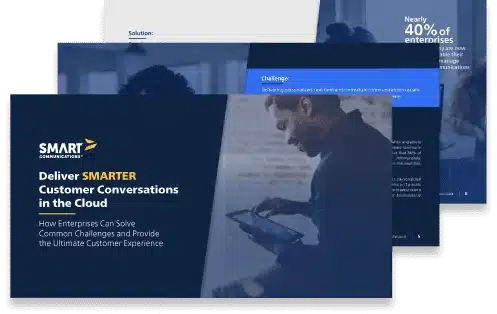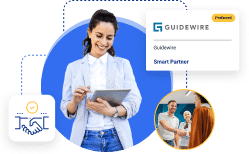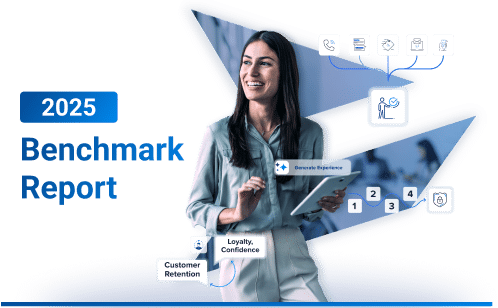Provide a Better Customer Onboarding Experience with Enterprise Forms Automation
By Sally Schulte, Product Marketing Director at Smart Communications
Creating the right customer onboarding experience is part science, part art. Because an individual’s perception is subjective, companies will walk a mile in their customers’ shoes to gain perspective and ask “which parts of the onboarding process are the most difficult,” “which parts are negatively impacting the experience,” and “how do we improve?” In many cases, where to begin can be the biggest hurdle to initiating a change—but it is one worth tackling.
We all know first impressions matter. In fact, the first 90 days of the customer journey are the most critical in establishing a positive long-term relationship. Enterprise forms automation is an attainable (often overlooked) solution that quickly streamlines your onboarding processes and provides an end-to-end digital customer onboarding experience — one that expedites the overall process and improves the experience. Discover how forms automation software helps you create an exceptional customer onboarding experience that sets you apart from the competition.
The Current State of Customer Onboarding
Customer onboarding is any activity that helps new customers or members acquaint themselves to your business and systems as well as your products or services, and it helps your company remain compliant with related regulatory requirements. Enterprises like yours work tirelessly to ensure customers have the right resources and information to move forward efficiently and with as little effort as possible. However, there may be disconnects in your onboarding experience that leave customers feeling that it wasn’t as smooth or seamless as they would have liked.
Organizations across the healthcare, insurance, and financial services industries face unique challenges in ensuring a seamless and efficient onboarding experience. Factors such as new or changing regulations, lengthy form processes, manual data entry, compliance protocols, and the risk of errors or (even worse) a security breach can make transformation feel like an insurmountable task. The key is finding a technology that is fit for purpose, easy to implement, and can connect with other technologies across the enterprise to provide meaningful impact at scale.
Customer expectations are growing and shifting—especially their digital expectations. While the preference for companies and customers for digital-first experiences isn’t new, there’s still work to be done. Improving customer engagement within the first 90 days can be as simple as prefilling a form with information you already know about someone. Or it can be giving them the ability to upload photos, sign (with their finger) on the dotted line or providing a fully mobile experience.
How Does Forms Automation Software Enhance the Customer Onboarding Experience?
With more importance being placed on efficiency and personalized experiences, your business needs solutions and strategies that make fully digital customer onboarding the norm. Forms automation software is built with the purpose of simplifying the data collection process, ensuring data accuracy, and reducing the amount of effort for customers and employees when entering new patient or member information. With advanced features and functionalities such as internal collaboration tools, electronic and digital signature options, automatic data and approval workflows, and turnkey implementation, this type of software eliminates the tedious and time-consuming manual steps that comprise these older processes. It also creates the personalization that builds trust and makes customers feel recognized through the use of prepopulated, known information. This can influence not just whether someone chooses you for the service or benefit they need today, but if they use you for the business they will want to conduct in the future.
When looking at operational efficiencies, customer onboarding can be a labor-intensive and lengthy process. It requires back-and-forth communications, multiple approvals, and gathering additional information along the way. This requires time and effort from various stakeholders or departments within the business as well as from customers, as they call and inquire about the status of their submission. Forms automation software automates the approval process (even with multiple approvers) and provides real-time status updates to customers, letting them know that things are moving right along. The right solution can take a fragmented, messy onboarding process and create an automated, personalized customer onboarding experience.
Considering today’s customers can acquire nearly anything they want in a matter of seconds, people expect ultra-fast-paced interactions. In fact, studies have shown that nearly 50% of internet users expect web page load times of less than two seconds. If a page doesn’t load within three seconds, visitors high tail it to a competitor’s site. So, the more accessible you make solutions to a customer’s problem or request, the more likely they are to move forward. If a customer or new member is required to print, sign, and scan physical documents, you’ve already asked them to do too much.
What Are the Best Strategies for Creating a Seamless Customer Onboarding Experience?
Did you know that 60% of customers will abandon a form if it’s too difficult to complete? To ensure you’re providing the best experience, one that enables customers rather than deters them, we suggest you develop a seamless approach to customer onboarding.
Below, we outline a few practical steps you can take to create a seamless customer onboarding experience.
-
Design mobile-friendly forms that capture essential information efficiently. An industry-leading forms experience is mobile responsive and fully secure. Data collection should be limited to entering only relevant information, based on what a person wants to do.
-
Leverage integrations to reduce manual data entry and eliminate costly errors. With real-time data validation, customers can be notified of missing or incorrect information as they complete forms, reducing need for follow-up and data re-entry.
-
Ensure compliance and security—and build trust and confidence from day one. Securing PII data and ensuring compliance for manual forms processes is nearly impossible. Digital onboarding not only reduces the risk of compromised customer data. It offers a digitally auditable trail to help maintain compliance.
-
Make forms accessible. Digital forms should be accessible to customers with disabilities. Use appropriate formatting like larger text, high-contrast colors, and alternative text descriptions for images to be WCAG-compliant.
-
Enable and empower non-technical users. Reducing the need for IT involvement is a key factor in enabling business ownership and operational efficiency. It also allows IT departments to focus on innovative initiatives that help the business grow. Low-code solutions empower non-technical users to update forms in real-time or create new projects in a matter of hours.
These are just a few of the strategies and tips to effectively utilizing a leading forms automation solution.
Learn how a leading forms automation solution can help enterprises like yours enhance their customer onboarding experience.
Maximizing Customer Onboarding Efficiency with Enterprise Forms Management Solutions
Leading enterprise forms management solutions help organizations like yours unlock the full potential of your customer onboarding process. Integration with core systems enables centralized data and document processing that helps streamline workflows and achieve unprecedented efficiency without putting undue strain on customers and employees.
Speaking of employees, forms management software means that data entry teams don’t need to be co-located with the mail room. Approvers and stakeholders can digitally re-route for approvals or reviews when they are out of the office. And companies don’t need to worry about filing or destroying documentation that contains personal data. These are significant factors in today’s remote and hybrid-model work environment.
And the ideal onboarding experience doesn’t end with the final submission. When customers can self-serve and get acquainted with your company securely, it reduces follow-up calls to customer contact centers. This allows agents to focus on serving other customers and supporting other parts of the business.
Conclusion
The most important thing to remember is that the customer onboarding experience can be a make-or-break moment for your company. First impressions set the tone for how a customer will inevitably interact with your company throughout the life of their relationship with the brand. Embracing cloud enterprise forms automation solutions to help optimize your operations and deliver an exceptional experience will elicit big benefits in the long run and help your organization be customer centric from end to end.



